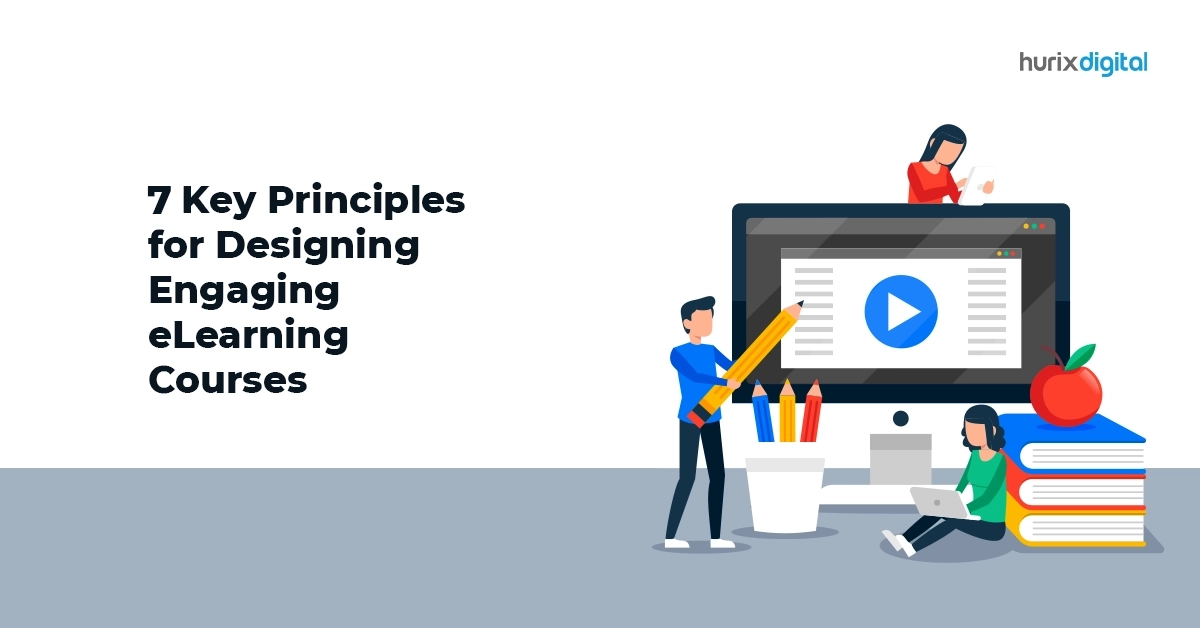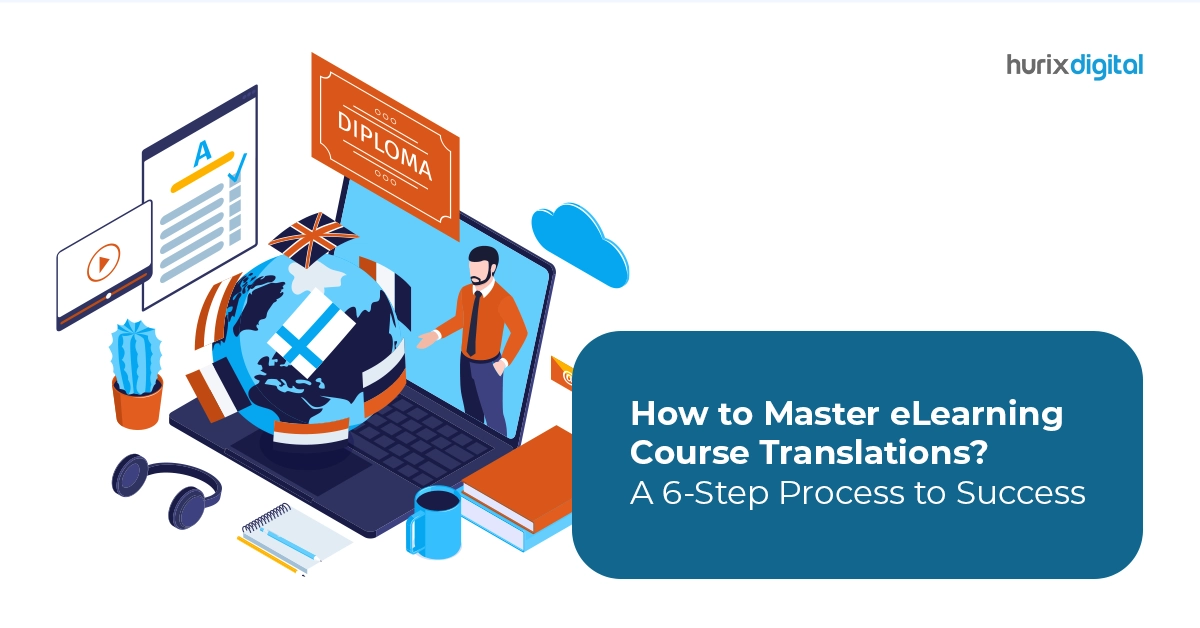Summary
Explore the essential principles for designing engaging eLearning courses, from user-centric design to adaptability for diverse audiences. Uncover the transformative benefits for enhanced employee performance and cost-effective training solutions. Partner with Hurix Digital for a strategic approach to eLearning excellence.
Designing engaging elearning courses requires more than just transferring information online. This comprehensive guide explores key principles to turn your enterprise learning initiatives into dynamic, interactive experiences that captivate learners and boost knowledge retention.
The landscape of learning has shifted dramatically, with eLearning courses becoming a cornerstone of enterprise learning. But simply placing content online isn’t enough. To truly engage learners and drive knowledge retention, effective eLearning design is crucial.
Table of Contents:
- Seven Key Principles for Designing Engaging eLearning Courses
Section 1: Understanding the Core Designing Principles
Section 2: The Importance of Designing Engaging eLearning Courses
Section 3: The Transformative Benefits of Designing Engaging eLearning Courses - Other Important Elements for Designing Engaging eLearning Courses
- Conclusion
Seven Key Principles for Designing Engaging eLearning Courses
Section 1: Understanding the Core Designing Principles
Before embarking on the journey of designing engaging eLearning courses, it is paramount to grasp the fundamental principles that govern this intricate process.
Principle 1: User-Centric Design In the realm of eLearning, user-centric design places the learner at the forefront. Tailoring the elearning course to meet the unique needs, preferences, and challenges of the audience is the bedrock of effective engagement.
Principle 2:Interactive Learning Elements Static content no longer suffices. Integrating interactive elements, such as quizzes, simulations, and discussions, transforms a conventional elearning course into an immersive and engaging educational experience.
Principle 3:Multimodal Content Delivery Recognizing the diversity in learning preferences, a judicious blend of textual, visual, and auditory elements ensures a holistic learning environment, catering to a broad spectrum of learners.
Section 2: The Importance of Designing Engaging eLearning Courses
Understanding why designing engaging eLearning courses is vital provides the context for implementing these principles effectively.
Principle 4: Increased Learner Retention Engagement is the key to retention. A well-designed eLearning course captivates learners, embedding knowledge for long-term recall. These principles serve as a guide in creating an environment conducive to learning retention.
Principle 5: Adaptability to Diverse Audiences In the corporate realm, where diversity is the norm, designing engaging eLearning courses ensures content resonates with a varied audience, regardless of background, skills, or learning preferences.
Section 3: The Transformative Benefits of Designing Engaging eLearning Courses
Beyond the elearning course itself, these principles yield transformative benefits for both learners and organizations.
Principle 6: Enhanced Employee Performance Investing in engaging eLearning courses directly correlates with improved employee performance. The principles guide organizations in aligning courses with learning goals, enhancing workforce competence.
Principle 7: Cost-Effective Training Solutions Intelligently designed eLearning courses minimize the need for traditional training methods, significantly reducing costs associated with travel, accommodation, and printed materials. The principles underscore the importance of efficiency in training delivery.
Also Read: What is an eLearning Module? Know the Benefits, Challenges & Future of eLearning Modules
Other Important Elements for Designing Engaging eLearning Courses
- Know Your Audience: Understanding your learners’ demographics, prior knowledge, and learning styles is paramount. Tailor content, activities, and delivery methods to resonate with their needs and preferences.
- Define Clear Learning Objectives: Vague goals lead to aimless learning. Set SMART objectives (Specific, Measurable, Achievable, Relevant, and Time-bound) to give learners a roadmap for success.
- Embrace Microlearning: Break down complex topics into bite-sized, focused modules. This reduces cognitive overload and allows learners to conquer small victories, fueling motivation.
- Storytelling is Key: Weave narratives into your elearning course to create emotional connections and enhance content recall. Real-life examples, case studies, and interactive scenarios bring learning to life.
- Visual Appeal Matters: Ditch text-heavy presentations. Integrate high-quality graphics, videos, animations, and infographics to visually represent concepts and spark learner interest.
- Interactive Experiences Rule: Passive absorption yields poor retention. Make your elearning course interactive with quizzes, polls, simulations, branching scenarios, and collaborative activities.
- Embrace Active Learning: Don’t just tell, show, and do. Engage learners in problem-solving exercises, role-playing activities, and real-world application tasks to solidify their understanding.
- Feedback is Fuel: Timely and constructive feedback is essential for growth. Utilize quizzes, self-assessments, and peer review activities to provide personalized feedback and guide learners on their learning path.
- Embrace Accessibility: Ensure your elearning course is inclusive for all learners. Follow accessibility guidelines, offer closed captions for videos, and provide alternative text descriptions for visuals.
- Gamification Enhances Engagement: Integrate game mechanics like points, badges, and leaderboards to motivate learners and foster a sense of competition.
- Make it Mobile-Friendly: Optimize your elearning course for mobile devices. Responsive design and bite-sized modules ensure convenient learning anytime, anywhere.
- Social Learning Power: Nurture a community of learners through discussion forums, chat rooms, and collaborative projects. Peer interaction reinforces understanding and fosters a sense of belonging.
- Personalize the Experience: Go beyond a one-size-fits-all approach. Leverage adaptive learning technologies to personalize content and learning paths based on individual learner needs and progress.
- Keep it Fresh and Updated: Stagnant content leads to disengagement. Regularly update your elearning course with new material, industry trends, and real-world examples to maintain relevance and learner interest.
- Measure and Evaluate: Data is your friend. Track learner progress, completion rates, and engagement metrics to identify areas for improvement and optimize your elearning course for maximum impact
Also Read: How to Design & Develop e Learning Modules for Small, Medium and Large Enterprises
Conclusion: Partnering for Excellence with Hurix Digital
As you embark on the journey of mastering these 7 key principles, consider Hurix Digital as your strategic partner in eLearning excellence. With a proven track record in delivering cutting-edge solutions, Hurix Digital stands ready to empower your enterprise learning initiatives.
Elevate your learning experience with Hurix Digital. Explore our comprehensive eLearning solutions tailored for your enterprise. Contact us today to unlock the full potential of your workforce.










